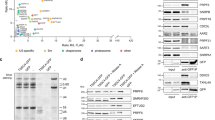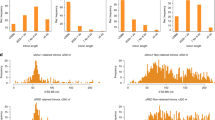Abstract
SPLICING of pre-messenger RNA in eukaryotic cells occurs in a multicomponent complex termed the spliceosome, which contains small nuclear ribonucleoprotein particles (snRNPs), protein fac-tors and substrate pre-mRNA1–3. Assembly of the spliceosome involves the stepwise binding of snRNPs and protein factors to the pre-mRNA through a poorly understood mechanism which probably involves specific RN–RNA, RNA–protein and protein–protein interactions. Of particular interest are the interactions between snRNPs, which are likely to be important not only for assembly of the spliceosome but also for catalysis. Ul snRNP interacts with the 5′ splice site and U2 snRNP with the branch site of the pre-mRNA; both of these interactions involve Watson–Crick base pairing4–9. But very little is known about how other factors such as the U4/U6 and U5 snRNPs reach the spliceosome and function in splicing. Here we report evidence that U6 snRNA interacts directly with U2 snRNA by a mechanism involving base-pairing, and that this interaction can be necessary for splicing of a mammalian pre-mRNA in vivo.
This is a preview of subscription content, access via your institution
Access options
Subscribe to this journal
Receive 51 print issues and online access
$199.00 per year
only $3.90 per issue
Buy this article
- Purchase on Springer Link
- Instant access to full article PDF
Prices may be subject to local taxes which are calculated during checkout
Similar content being viewed by others
References
Padgett, R. A., Grabowski, P. J., Konarska, M. M., Seiler, S. & Sharp, P. A. A. Rev. Biochem. 55, 1119–1150 (1986).
Maniatis, T. & Reed, R. Nature 325, 673–678 (1987).
Steitz, J. A. et al. in Structure and Function of Major and Minor Small Nuclear Ribonucleoprotein Particles (ed. Birnstiel, M. L.), 115–154 (Springer, Berlin, 1988).
Zhuang, Y. & Weiner, A. M. Cell 46, 827–835 (1986).
Siliciano, P. G. & Guthrie, C. Genes Dev. 2, 1258–1267 (1988).
Seraphin, B., Kretzner, L. & Rosbash, M. EMBO J. 7, 2533–2538 (1988).
Wu, J. & Manley, J. L. Genes Dev. 3, 1553–1561 (1989).
Zhuang, Y. & Weiner, A. M. Genes Dev. 3, 1545–1552 (1989).
Parker, R., Siliciano, P. G. & Guthrie, C. Cell 49, 229–239 (1987).
Noble, J. C. S., Pan, Z.-Q., Prives, C. & Manley, J. L. Cell 50, 227–236 (1987).
Noble, J. C. S., Prives, C. & Manley, J. L. Genes Dev. 2, 1460–1475 (1988).
Fu, X.-Y. & Manley, J. L. Molec. cell Biol. 7, 738–748 (1987).
Fu, X.-Y., Colgan, J. D. & Manley, J. L. Molec. cell Biol. 8, 3582–3590 (1988).
Black, D., Chabot, B. & Steitz, J. A. Cell 42, 737–750 (1985).
Frendewey, D., Kramer, A. & Keller, W. Cold Spring Harb. Symp. quant. Biol. LII, 287–298 (1987).
Hausner, T.-P., Giglio, L. M. & Weiner, A. M. Genes Dev. 4, 2146–2156 (1990).
Kunkel, G. R. & Pederson, T. Genes Dev. 2, 196–204 (1988).
Madhani, H. D., Bordonne, R. & Guthrie, C. Genes Dev. 4, 2264–2277 (1990).
Fabrizio, P., McPheeters, D. S. & Abelson, J. Genes Dev. 3, 2137–2150 (1989).
Liao, X., Kretzner, L., Seraphin, B. & Rosbash, M. Genes Dev. 4, 1766–1774 (1990).
Black, D. & Steitz, J. A. Cell 46, 697–704 (1986).
Vankan, P., McGuigan, C. & Mattaj, I. W. EMBO J. 9, 3397–3404 (1990).
Lamond, A. I., Sproat, B., Ryder, U. & Hamm, J. Cell 58, 383–390 (1989).
Blencowe, B., Sproat, B. S., Ryder, U., Barbino, S. & Lamond, A. I. Cell 59, 531–539 (1989).
Guthrie, C. & Patterson, B. A. Rev. Genet. 22, 387–419 (1988).
Shannon, K. W. & Guthrie, C. Genes Dev. 5, 773–785 (1991).
Michel, F., Umesono, K. & Ozeki, H. Gene 82, 5–30 (1989).
Sharp, P. A. Cell 42, 397–400 (1985).
Cech, T. R. Cell 44, 207–210 (1986).
Kunkel, T. A., Roberts, J. D. & Kakour, R. A. Meth. Enzym. 154, 367–382 (1987).
Sanger, F., Nicklen, S. & Coulson, A. R. Proc. natn. Acad. Sci. U.S.A. 74, 5462–5467 (1977).
Datta, B. & Weiner, A. M. Nature 352, 821–824 (1991).
Author information
Authors and Affiliations
Rights and permissions
About this article
Cite this article
Wu, J., Manley, J. Base pairing between U2 and U6 snRNAs is necessary for splicing of a mammalian pre-mRNA. Nature 352, 818–821 (1991). https://doi.org/10.1038/352818a0
Received:
Accepted:
Issue Date:
DOI: https://doi.org/10.1038/352818a0
This article is cited by
-
A heuristic model for computational prediction of human branch point sequence
BMC Bioinformatics (2017)
-
Crystal structures of the Lsm complex bound to the 3′ end sequence of U6 small nuclear RNA
Nature (2014)
-
Cwc2 and its human homologue RBM22 promote an active conformation of the spliceosome catalytic centre
The EMBO Journal (2012)
-
Splicing double: insights from the second spliceosome
Nature Reviews Molecular Cell Biology (2003)
-
Evidence for an essential non-Watson–Crick interaction between the first and last nucleotides of a nuclear pre-mRNA intron
Nature (1993)
Comments
By submitting a comment you agree to abide by our Terms and Community Guidelines. If you find something abusive or that does not comply with our terms or guidelines please flag it as inappropriate.



